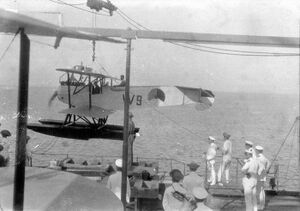Engineering:Hansa-Brandenburg W.12
| W.12 | |
|---|---|

| |
| Van Berkel W-A, above cruiser Java | |
| Role | Floatplane fighter |
| Manufacturer | Hansa-Brandenburg |
| Designer | Ernst Heinkel |
| First flight | Early 1917 |
| Primary users | Kaiserliche Marine Marine-Luchtvaartdienst |
| Number built | 181 |
The Hansa-Brandenburg W.12 was a German biplane fighter floatplane of World War I. It was a development of Ernst Heinkel's previous KDW, adding a rear cockpit for an observer/gunner, and had an unusual inverted tailfin/rudder (which instead of standing up from the fuselage, hung below it) in order to give an uninterrupted field of fire.
The W.12s (under the Naval designation C3MG) served on the Western Front, based at the Naval air bases at Ostend and Zeebrugge. The aircraft had some success, and one shot down the British airship C.27.
In April 1918, a W.12 made an emergency landing in the neutral territory of the Netherlands, where it was interned and flight tested by the Dutch. In 1919 the government of the Netherlands bought a licence to build the aircraft. 35 W.12s were subsequently manufactured by the Van Berkel company of Rotterdam as the W-A, serving with the Dutch Naval Air Service until 1933.
Variants
- W.12 : German Navy model. 146 built.
- Van Berkel W-A : Dutch licence-built W.12, with Benz engine. 35 built.
Operators
 German Empire
German Empire
- Kaiserliche Marine
 Netherlands
Netherlands
- Dutch Naval Aviation Service
Specifications (W.12)
Data from Encyclopedia of Military Aircraft[1]
General characteristics
- Crew: 2
- Wingspan: 9.6 m (31 ft 6 in)
- Height: 3.3 m (10 ft 10 in)
- Wing area: 36.2 m2 (390 sq ft)
- Empty weight: 997 kg (2,198 lb)
- Gross weight: 1,454 kg (3,206 lb)
- Powerplant: 1 × Mercedes D.III 6-cylinder water-cooled in-line piston engine, 119 kW (160 hp)
- Propellers: 2-bladed fixed-pitch propeller
Performance
- Maximum speed: 160 km/h (99 mph, 86 kn)
- Range: 520 km (320 mi, 280 nmi)
- Endurance: 3 hours 30 minutes
- Service ceiling: 5,000 m (16,000 ft)
Armament
- Guns: :* 1 or 2 × fixed forward 7.92 (0.312 in) lMG 08 machine guns
- 1 × 7.92 (0.312 in) Parabellum MG14 in rear cockpit
See also
Related development
Related lists
- List of military aircraft of Germany
- List of seaplanes and flying boats
References
- ↑ Jackson, Robert (2003). The encyclopedia of military aircraft. Bath: Parragon Pub. ISBN 9780752581309. https://archive.org/details/encyclopediaofmi0000jack.
Bibliography
- Klaauw, Bart van der (March–April 1999). "Unexpected Windfalls: Accidentally or Deliberately, More than 100 Aircraft 'arrived' in Dutch Territory During the Great War". Air Enthusiast (80): 54–59. ISSN 0143-5450.
- Herris, Jack (2012). German Seaplane Fighters of WWI: A Centennial Perspective on Great War Seaplanes. Great War Aviation Centennial Series. 2. Charleston (S.C.): Aeronaut Books. ISBN 978-1-935881-09-4.
- Owers, Colin A. (2015). Hansa-Brandenburg Aircraft of WWI: Volume 2–Biplane Seaplanes. Great War Aviation Centennial Series. 18. n.p.: Aeronaut Books. ISBN 978-1-935881-32-2.
External links
 |


